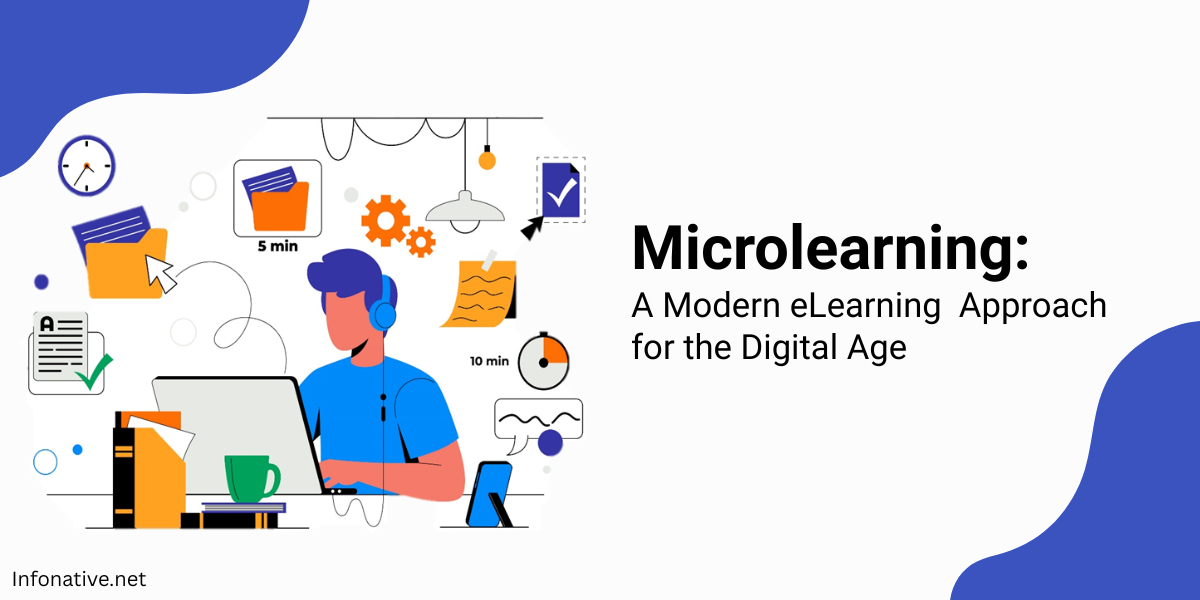What is Microlearning?
Microlearning involves providing educational content in short, targeted bursts, allowing learners to choose what and when they want to learn. These sessions are usually brief—often lasting five minutes or less—and concentrate on a single learning goal.
By breaking information into manageable chunks, microlearning respects modern learners' time constraints and attention spans, making learning more accessible and digestible.
Evolution of eLearning: How Microlearning Emerged
Traditional eLearning began as lengthy online courses packed with extensive information, resembling full-day workshops. However, with the advent of mobile technology and shifting learning behaviors, a need for quicker, more efficient learning experiences arose.
Microlearning evolved as a natural response to:
• Busy lifestyles
• Reduced attention spans
• Need for on-demand information
• Increased reliance on mobile devices for learning
Organizations realized that shorter, targeted learning moments not only kept learners engaged but also improved knowledge retention dramatically.
Why Microlearning is Perfect for the Digital Age
Today’s learners crave information that’s quick, accessible, and easy to understand. Microlearning checks all these boxes. With mobile usage at an all-time high, learners can complete a module during a coffee break or commute. Plus, it aligns with cognitive science principles that favor learning in small, repeated bursts.
The digital era demands learning experiences that are:
• Mobile-friendly
• Highly relevant
• Easily consumable
• Available on-demand
That’s why microlearning is considered a perfect match for the digital generation.
Key Features of Microlearning
Short Learning Modules
Microlearning modules typically span 3 to 10 minutes, allowing learners to absorb key concepts without feeling overwhelmed. The focus remains on one objective per module, ensuring clarity and purpose.
Mobile-First Design
Since learners are increasingly using smartphones and tablets, microlearning often adopts a mobile-first design strategy. This ensures seamless access to training materials anytime, anywhere.
Just-in-Time Learning
Need an answer on the spot? Microlearning offers just-in-time learning opportunities where employees or learners can quickly find solutions without having to wade through irrelevant content.
Benefits of Microlearning for Learners
Increased Retention Rates
Studies have shown that breaking information into smaller parts enhances memory retention. When learners engage with bite-sized content, they’re more likely to recall information long-term.
Higher Engagement Levels
Shorter modules mean learners are less likely to feel fatigued or bored. Plus, interactive microlearning techniques like quizzes and videos foster a more engaging learning experience.
Benefits of Microlearning for Organizations
Cost-Effective Training
Developing short training modules is often less expensive than designing full-length courses. It also reduces the costs associated with long training sessions, such as employee downtime.
Faster Deployment
Organizations can create and deploy microlearning content quickly, making it ideal for industries with rapidly changing compliance requirements or product updates.
Popular Formats of Microlearning Content
Videos and Animations
Short, animated videos simplify complex information and cater to visual learners. They’re among the most popular microlearning formats.
Interactive Quizzes
Quizzes provide instant feedback and reinforce learning. They're perfect for knowledge checks after short lessons.
Infographics
Visual summaries of key points help learners quickly grasp and retain information. They’re ideal for data-heavy topics.
Best Practices for Creating Effective Microlearning Content
Focus on One Objective
Each module should concentrate on a single concept to avoid cognitive overload and enhance understanding.
Keep it Short and Sweet
Respect learners' time by delivering content that gets straight to the point without unnecessary fluff.
Use Rich Media
Incorporate videos, audio, infographics, and animations to cater to different learning styles and make the experience more engaging.
How to Implement Microlearning in Your Organization
1. Identify Learning Needs and Objectives
Analyze training goals and skill gaps to define clear microlearning objectives tailored to specific organizational needs.
2. Break Down Content into Bite-Sized Modules
Divide existing content into small, focused segments, each addressing one specific topic for easy and quick learning.
3. Choose the Right Tools and Platforms
Select mobile-friendly Learning Management Systems (LMS) or authoring tools that support interactive, engaging microlearning content delivery.
4. Incorporate Multimedia and Interactivity
Use videos, infographics, podcasts, and interactive quizzes to cater to various learning styles and maintain high engagement.
5. Measure, Improve, and Iterate
Track learner engagement and performance, gather feedback, and continuously refine microlearning modules to improve future learning experiences.
Common Challenges in Microlearning and How to Overcome Them
Not Ideal for Complex Topics
Microlearning works best for clear, targeted topics, while complex or in-depth subjects typically need more comprehensive training approaches.
Content Fragmentation
Breaking content into too many small parts can lead to disconnected learning experiences if not properly structured.
Limited Context
Short lessons may lack the broader context or background needed for full understanding, especially for new learners.
Requires High Initial Planning
While microlearning modules are short, designing an effective series of interconnected lessons takes significant upfront effort.
Learner Motivation Gaps
Since learners often drive their own progress, those lacking self-discipline might struggle to complete all modules.
Real-World Examples of Successful Microlearning Initiatives
• Google: Uses microlearning for employee onboarding and skill updates.
• IBM: Offers just-in-time micro-courses for software training.
• Unilever: Incorporates short learning bursts for leadership training.
These case studies prove that when done right, microlearning can drive significant results.
Future Trends in Microlearning
• Smart AI Customization: Adapting learning experiences to individual user habits and progress for personalized growth.
• Microlearning for Soft Skills: Training leaders and managers via bite-sized lessons.
• Gamification: Boosting engagement with challenges and incentive-driven rewards.
The future of microlearning is promising, especially with advancements in AI and mobile technology.
Conclusion
Microlearning isn’t just a trend—it’s transforming the way we learn and develop in today’s fast-moving digital world. It delivers unmatched efficiency, adaptability, and learner engagement. Organizations that adopt microlearning are more agile, innovative, and prepared for long-term success.
If you want a modern, scalable solution to enhance learning results, microlearning is the way forward—it's not just the future, it's already here.



